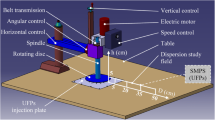Abstract
To organize in-furnace dust settling in the Vanyukov furnace at OAO SUMZ (Revda, Russia), acoustic emitter technology is used. The emitter design includes a nozzle tube, an air nozzle, a resonator, and a focusing surface. Starting from the surface area of the furnace melt bath and recommended specific acoustic power for in-furnace dust settling, the summary acoustic field sound power is calculated and the optimal amount and arrangement places of acoustic emitters are determined. To form the acoustic field in the Vanyukov furnace for melting copper sulfide zinc-containing feedstock and deplete liquid converter slags, four acoustic emitters are mounted in the end wall through an inspection window, two on the apothecary side and two on the loading side of charge materials. In general, six pilot modes of testing the in-furnace dust settling system with various operational settings of acoustic emitters and one base mode for comparing performance characteristics are implemented. The duration of pilot periods varies from 5 to 18 days, and the total aggregate service time is 68 days. The presence of the acoustic field in the working furnace space at any emitter operation settings promote a decrease in the concentration of dust particles after the chain of gas purifiers (in the commodity point). It is revealed by the experimental data that the minimal summary acoustic field sound power, which decreases the dust concentration due to the coagulation of dust particles inside the furnace space, is 800 W.
Similar content being viewed by others
References
Gushchin, S.N., Telegin, A.S., Lobanov, V.I., and Koryukov, V.N., Teplotekhnika i teploenergetika metallurgicheskogo proizvodstva (Thermal Engineering and Heat Power Engineering of Metallurgical Production), Moscow: Metallurgiya, 1993.
Vanyukov, A.V. and Utkin, N.I., Kompleksnaya pererabotka mednogo i nikelevogo syr’ya (Complex Processing of Copper and Nickel Raw Materials), Chelyabinsk: Metallurgiya, 1988.
Han Feng, Yu Fei, and Cui Zhaojie, Industrial metabolism of copper and sulfur in a copper-specific ecoindustrial park in China, J. Clean. Product., 2015, vol. 133, pp. 459–466.
Naboichenko, S.S., Ageev, N.G., Doroshkevich, A.P., Zhukov, V.P., Eliseev, E.I., Karelov, S.V., Lebed’ A.B., and Mamyachenkov S.V., Protsessy i apparaty tsvetnoi metallurgii (Processes and Apparatuses of Nonferrous Metallurgy), Yekaterinburg, UGTU-UPI, 2005.
Vaisburd, S., Berner, A., Brandon, D.G., Kozhakhmetov, S., Kenzhaliyev, E., and Zhalelev, R., Slags and mattes in Vanyukov’s process for the extraction of copper, Metall. Mater. Trans, 2015, vol. 33, no. 4, pp. 551–559.
Chen, L., Bin, W., Yang, T., Liu, W., and Bin, S., Research and industrial application of oxygen-rich side-blow bath smelting technology, in: Proc. 4th Int. Symp. on High-Temperature Metallurgical Processing (TMS 2013). Annual Meeting and Exhibition, San Antonio, TX: 2013. pp. 49–55.
Matyukhin, V.I., Yaroshenko, Yu.G., Matyukhin, O.V., Pan’shin, A.M., and Konovalov, I.S., Using the energy of the acoustic field to improve the performance of the shaft furnace, Tsvetn. Met., 2013, no. 8, pp. 64–70.
Asanov, D.A., Filyanova, L.A., Zapasnyi, V.V., and Sukhova, N.M., Study of the performance indices of a dust-cleaning system at the Balkhash copper smelter, Metallurgist, 2016, nos. 3–4, pp. 331–338.
Zhang, H.L., Zhou, C.Q., Bing, W.U., and Chen, Y.M., Numerical simulation of multiphase flow in a Vanyukov furnace, J. South. Afr. Inst. Mining Metall., 2015, vol. 115, no. 5, pp. 457–463.
Kutateladze, S.S., Teplo i massoobmen v zvukovom pole (Heat-and-Mass Exchange in the Sound Field), Novosibirks: Sib. Otd. Akad. Nauk SSSR, 1970.
Cafiero, G., Greco, C.S., Astarita, T., and Discetti, S., Flow field features of fractal impinging jets at short nozzle to plate distances, Exp. Therm. Fluid Sci., 2016, no. 78, pp. 334–344.
Andrade, M.A.B., Skotis, G.D., Ritchie, S.B., Cumming, D.R.S., Riehle, M.O., and Bernassau, A.L., Contactless acoustic manipulation and sorting of particles by dynamic acoustic fields, IEEE Trans. Ultrason. Ferroelectr. Freq. Contr., 2016, vol. 63, no. 10, pp. 1593–1600.
Dong, X.-R., Liu, Y.-X., Chen, Y.-H., and Dong, G., Research on control of hypersonic shock wave/boundary layer interactions by double micro-ramps, Binggong Xuebao. Acta Armament., 2016, vol. 37, no. 9, pp. 1624–1632.
Dolinskii, A.A., Basok, B.I., and Gulyi, S.I., Diskretno-impul’snyi vvod energii v teplotekhnologiiyah (Discrete-Pulsed Energy Input in Heat Technologies), Kiev, IFTT Nats. Akad. Nauk Ukrainy, 1996.
Seregin, P.S., Investigation into Gas Dynamics of the in-Furnace Space, Dust Escape, and Scull Formation in the Vanyukov Furnace with the Use of Physical Simulation, Cand. Sci. (Eng.) Dissertation, St. Petersburg: Gipronikel’, 2001.
Selivanov, E.N., Gulyaeva, R.I., Skopov, G.V., and Matveev, A.V., Material composition of the dust from the electrostatic precipitators of a Vanyukov furnace at the Middle Ural Copper Smelter, Metallurgist, 2014, nos. 5–6, pp. 431–435.
Kardashev, G.A., Fizicheskie metody intensifikatsii protsessov v khimicheskoi tekhnologii (Physical Methods of Intensifying Processes in Chemical Technology), Moscow: Khimiya, 1990.
Konovalov, I.S., Improvement of Thermal and Gas- Dynamic Operation of Shaft Copper Smelting Furnaces, Cand. Sci. (Eng.) Dissertation, Yekaterinburg: Ural Federal Univ., 2012.
Shilton, R.J., Yeo, L.Y., and Friend, J.R., Quantification of surface acoustic wave induced chaotic mixingflows in microfluidic wells, Sens. Actuat. B: Chem., 2011, vol. 160, no. 1, pp. 1565–1572.
Khabeev, N.S., Intensification of the effect exerted by bubbles on a body immersed in a liquid due to the radial bubble oscillations, J. Eng. Phys. Thermophys., 2015, vol. 88, no. 3, pp. 645–651.
Ivanovskii, A.I., Teoreticheskoe i eksperimental’noe izuchenie potokov, vyzvannykh zvukom (Theoretical and Experimental Study of Flows Caused by the Sound), Moscow: Gidrometeoizdat, 1959.
Rudenko, O.V. and Molen, S.I., Teoreticheskie osnovy nelineinoi akustiki (Theoretical Foundations of Nonlinear Acoustics), Moscow: Nauka, 1978.
Author information
Authors and Affiliations
Corresponding author
Additional information
Original Russian Text © V.I. Matyukhin, V.A. Goltsev, S.Ya. Zhuravlev, V.A. Dudko, 2017, published in Izvestiya Vysshikh Uchebnykh Zavedenii, Tsvetnaya Metallurgiya, 2017, No. 4, pp. 4–11.
About this article
Cite this article
Matyukhin, V.I., Goltsev, V.A., Zhuravlev, S.Y. et al. Using acoustic field energy to decrease dust discharge from the working space of the Vanyukov furnace. Russ. J. Non-ferrous Metals 58, 457–462 (2017). https://doi.org/10.3103/S1067821217050108
Received:
Accepted:
Published:
Issue Date:
DOI: https://doi.org/10.3103/S1067821217050108




